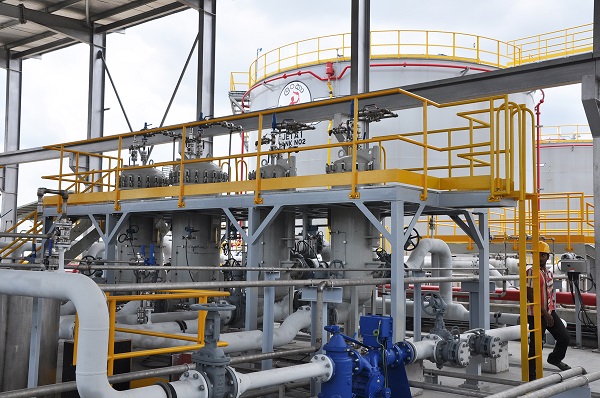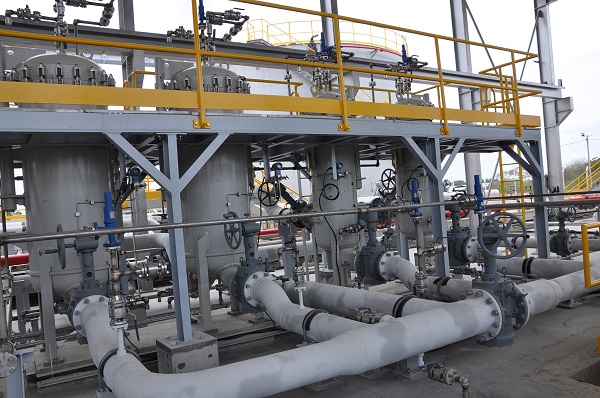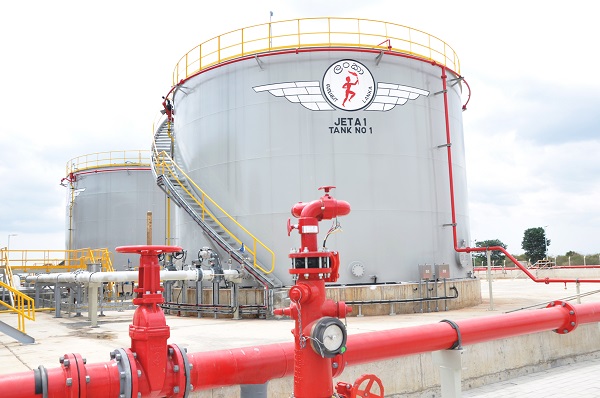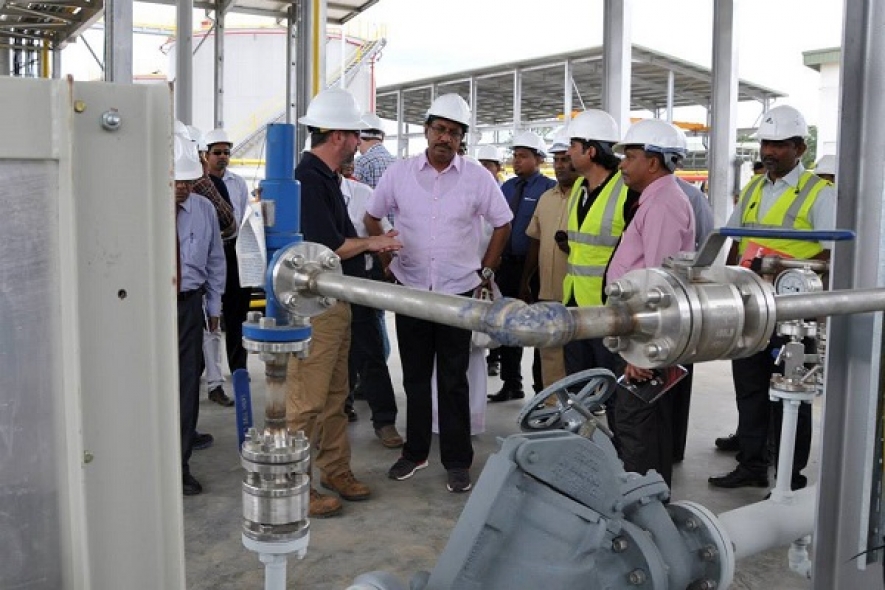Refueling aircraft by using Refueler tanker trucks is the commonly adopted methodology in the olden days. The first Fuel hydrant system was installed at the “Bandaranaike International Airport (BIA) during the year 1987 which could not utilized due to shortcomings in the existing Terminal facilities at the BIA.
The new Aviation Refueling Terminal at the BIA was constructed during the period from 2000 to 2003, connecting the fuel hydrant systems in existing Apron-A and Apron-B, construction a new fuel hydrant system in the new cargo Apron-C together with a state of the art automated refueling facility through the fuel hydrant system having a storage capacity for 8,200 M3 in three tanks.
A fuel hydrant system is a necessary requirement for a busy International Airport, to comply with very limited time allocations given for refueling aircraft where large aircraft cannot be refueled through Refueler trucks due to large volumes of fuel required to be filled within very short time periods. Fuel hydrant systems are very efficient, safe and an essential facility to attract airline customers to the airport. The refueling liability insurance premiums could be drastically reduced, having a fuel hydrant refueling facility in an airport. Meantime the government realized the importance of having a second International Airport in the country for many reasons such as an alternate airport to divert aircraft in an emergency, to ease up concession at the main airport at BIA, purposes such as aircraft maintenance, technical stops, tourism, diversification of development presently concentrated to Colombo, etc. The proposed second International Airport was initially located at Weerawila and subsequently relocated to Mattala, both in the Hambantota district due to environmental reasons. The Aviation refueling facility incorporated in to the overall plan of AASL and in the design of the Hambantota International Airport (HIA) by M/s. China Harbour Engineering Company (CHEC) did not have a Fuel Hydrant System and the required capacities in the fuel storage tanks and associated facilities, required for an International Airport of this nature.
The CPC and the Ministry of Petroleum Industries and the Hon. Minister was compelled to undertake the task of building a state of the art Fuel Hydrant System and an Aviation Refueling Terminal with the required storage capacities of Jet A1 fuel in the year 2010, due to the inability of Airport & Aviation Services (Lanka) Ltd. (AASL) to revise their original designs of CHEC, and to find additional funding requirement for the improved and enhanced design of the required Aviation Refueling facility. . Initial design of the fuel farm was only adequate for very small airport and not at all sufficient for an international airport which requires a large storage to maintain an adequate buffer stock for any eventuality.
The Fuel hydrant system within the apron area was constructed by the main Airport contractor M/s.China Harbour Engineering Company (CHEC) for a negotiated price of US$.7,175,326.13 without any variation claims approved. The construction of the Aviation Terminal and the interconnecting pipelines of 1.2 Km long was assigned to M/s. Amana Pipeline Construction LLC of Dubai, UAE on a competitive tender basis with a Cabinet approval for US$.31,251,504.02 which has been successfully completed without any extra cost to CPC. The total project has cost CPC nearly Rs. 5.0 billion using it’s own funding. It is noted that construction of an automated Fuel Hydrant System and an Aviation Refueling facility meeting relevant International standards and the mandatory requirements of the “Joint Inspection Group” (JIG) and the International Airlines has more or less become necessary in all the newly built International Airports in the world. The main reasons being improved safety in hydrant refueling and efficient and faster refueling operation within the very short times allocated for refueling larger aircraft due to busy and quick turnaround schedules, compared to olden days aircrafts which uplifted only very small amount of fuel.
The Aviation refueling facility at MRIA has been designed with an automated Fuel hydrant system for refueling all types of aircraft, and Refueler trucks for refueling smaller aircraft which also has the capability of refueling aircraft parked at locations outside designated apron areas and also a requirement for CPC is to handle all types of aircraft that call at the airport. MRIA has been designed to handle Airbus A380 aircraft which has a fuel capacity of 310,000 liters of Jet-A1 fuel. Some of the other larger aircrafts expected at MRIA are “Antonov 124” which has 348,000 liters capacity, “Boing 747” has 216,000 Liters capacity, “Airbus 340-300” has 140,000 Liters capacity, “Airbus 340-600” has 150,000 liters capacity and “Boing 777-200” has 117,300 Liters capacity fuel tanks. The latest Refueler trucks have a capacity of 30,000 liters only, which can refuel smaller aircrafts and also used for defueling excess fuel from aircrafts due load adjustment and maintenance purpose at customer request. The CPC Aviation Terminal is provided with 3.0 million liters of Jet-A1 fuel storage (3 x 1.0 M liters tanks), online filtering and sampling facilities, automated pumping system, emergency shutdown system at both apron and terminal, Fire detection and firefighting systems, refueler loading and off-loading facilities, inventory management and quality control systems, total backup power generation systems in a total blackout situation and many more systems and facilities to make it a fully-pledged facility meeting all international and Aviation Industry standards using all reputed brands of European/British/American equipment and materials for efficient, reliable and trouble free refueling operation which can win the heart of the customer on the journey to wonder of Asia.
All the designs have been reviewed, verified and approved by a team of qualified and experienced Engineers of the CPC and a reputed Third Party Inspection Company M/s. Germanischer Lloyd Colombo (Pvt) Ltd., in addition to the Contractor’s design consultants and Engineers. All the procurements and construction activities have been closely monitored by the Engineers of the CPC in-house Project Management team, Third Party Inspector, in addition to the contractor’s project Management team.
The Contract Agreement with the main construction contractor also incorporated all the equipment and facilities required for refueling aircraft without any interruption during the interim period, between the MRIA opening date and the date of commencement of operation at the CPC fuel hydrant system and the Aviation Terminal facility with a JIG certified temporary license from the Civil Aviation Authority, ensuring MRIA to be a fully functional Airport.
The required Jet-A1 fuel will be initially supplied by 33,000 liters capacity Road Tankers from the CPSTL Kolonnawa installation, until the SLPA Aviation storage tank farm at the Hambantota Port facility is ready for operations. A pipeline corridor from Hambantota Port to MRIA over a length of around 32 KM has been allocated by the RDA for a Jet-A1 transfer pipeline to be constructed in the future, based on the increasing demand for Jet-A1 at MRIA. It is anticipated that the functioning of the automated Fuel hydrant system along with the state of the art Aviation Terminal facility will become an important milestone in the Aviation Industry in Sri Lanka in many ways for the economic development, employment generation and regional development in the near future.(KH/SI)



